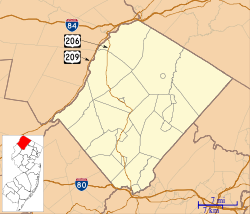Minisink Archeological Site | |
 South bank of Raymondskill Creek near confluence with Delaware River. The bank is eroding into the Manna archeological site. | |
| Nearest city | Bushkill, Pennsylvania and Millbrook, New Jersey |
|---|---|
| Area | 1,320 acres (530 ha) |
| NRHP reference No. | 93000608 [1] |
| Significant dates | |
| Added to NRHP | April 19, 1993 [1] |
| Designated NHL | April 19, 1993 [2] |
Minisink Archeological Site, also known as Minisink Historic District, is an archeological site of 1320 acres located in both Sussex County, New Jersey and Pike County, Pennsylvania. [3] It was part of a region occupied by Munsee-speaking Lenape that extended from southern New York across northern New Jersey to northeastern Pennsylvania. The Munsee were speakers of one of the three major language dialects of the Lenape Native American tribe. This interstate territory became the most important Munsee community for the majority of the 17th and 18th centuries. [2]
History
The area has supported human habitation for 10,000 years. [3] The site's archeology has been studied for more than 100 years, since the discovery in 1900 of Native American burials, and Indian and European artifacts. Since the late twentieth century, researchers have concentrated on trying to understand Native American cultures rather than simply retrieve artifacts and antiquities. [3] "Today, Minisink remains one of the most extensive, best preserved, and most intensively studied archeological locales in the Northeast." [2]
The site was declared a National Historic Landmark in 1993. [2] Excavations at the site have helped reveal historic interactions between European and Lenape people in Munsee country. Hundreds of early stone tools recovered at the site, along with remains of fish and fruit, indicated a more diverse diet than previously expected by researchers. [4]
Two 100-year floods, one in September 2004 and one in April 2005, caused severe erosion to one of the contributing archeological sites, 36Pi04 (Manna Site) located at the confluence of the Raymondskill Creek and Delaware River. Approximately 20% of the site was compromised during the floods. The National Park Service is collaborating with the Temple University Department of Anthropology to stabilize the banks as well as conduct archeological research and field schools at the site. [3]
See also
- National Register of Historic Places listings in Sussex County, New Jersey
- National Register of Historic Places listings in Pike County, Pennsylvania
- List of Native American archaeological sites on the National Register of Historic Places in Pennsylvania
- List of National Historic Landmarks in Pennsylvania
- List of National Historic Landmarks in New Jersey
References
- ^ a b "National Register Information System". National Register of Historic Places. National Park Service. July 9, 2010.
- ^ a b c d "Minisink Archeological Site". National Historic Landmark summary listing. National Park Service. Archived from the original on October 12, 2006. Retrieved February 11, 2008.
- ^ a b c d John R. Wright, "Archeology in the Minisink Today", Spanning the Gap, Vol. 25 No. 2, Summer 2003, National Park Service
- ^ "Historical Marker Dedicated in Smithfield Township: Minisink Hills"[ permanent dead link], Monroe County Historical Association. July 2010, Web. March 2011
External links
![]() Media related to
Minisink Archaeological Site at Wikimedia Commons
Media related to
Minisink Archaeological Site at Wikimedia Commons
- Delaware Water Gap National Recreation Area
- National Historic Landmarks in Pennsylvania
- National Historic Landmarks in New Jersey
- Geography of Pike County, Pennsylvania
- Archaeological sites in New Jersey
- Archaeological sites on the National Register of Historic Places in Pennsylvania
- Native American history of New Jersey
- Native American history of Pennsylvania
- National Register of Historic Places in Sussex County, New Jersey
- 1900 archaeological discoveries
- Archaeological sites on the National Register of Historic Places in New Jersey



